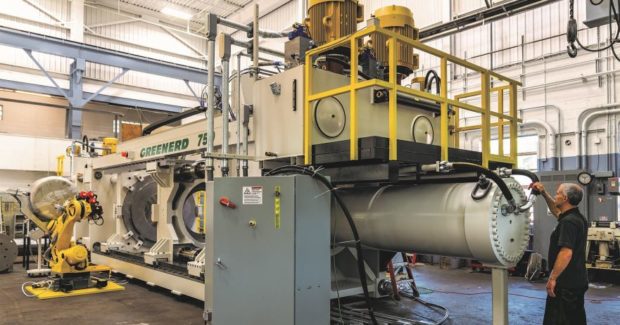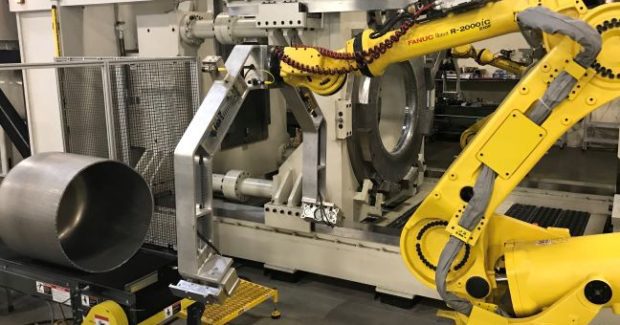Uniting Press and Automation
You will meet or exceed expectations by partnering with a press manufacturer that is an authorized systems integrator, and truly understands the scope of your goals by adding a fully integrated automation solution.
Posted: October 25, 2021
METAL FORMING & FABRICATING
By Rob Bisbee
You may have been thinking about purchasing a press or you might already have one or several. You probably have a view of how the overall process should flow through the press(es). This vision might include unfulfilled simple automation or extremely developed automated robotic turnkey cell, but the need to produce more high-quality parts/products repeatably is real.
Now, where to start? This is right where a world-class press manufacturer can not only meet but exceed your expectations by providing the press with the right robust, fully integrated automation solution.
WHY PRESS AUTOMATION?
There are many ways and reasons to automate a press, from simple to the very complex. Examples may include:
- Adding operator production indicators for proper part loading feedback, stuck part indicators, and part quality reporting
- Adding a raw material feeder, controlled by the press
- Integrating a scrap removal system or re-winder system
- Adding automatic die loading and unloading controls
- Installing product transport conveyors/mechanisms to load and unload the press
- Installing load and/or unload robots, both large and small
- Installing cobots (collaborative robots that work safely side-by-side with the existing operators to perform more cumbersome or repetitive tasks without any guarding)
- Adding automated inspection systems (sensors, lasers, cameras)
- Pushing recipes (setup parameters) to a press from a remote production control system (sometimes this includes pulling production data from a press to a remote data analyzer as well)
- Integrating multiple presses in a fully automated working cell
- Designing and adding custom part handling systems
Benefits of Automation (not in any order):
- Increasing throughput – decreased cycle times
- Reducing waste
- Increasing quality/consistency of parts
- Reducing production costs
- Ease of changeover
- Metrics accuracy and visibility
- Freeing up human resources to be re-tasked within the organization
- Reliable and predicable production rates
- Increasing floor space utilization
- Reducing lead times
- Reducing or eliminating a bottleneck in production
- Increasing in machine (press) utilization time
WHERE TO START
The press functionality is at the core of these types of automation projects. Partnering with a press manufacturer who is also an authorized system integrator and has a long history of providing integrated press automation solutions for a wide range of applications is very advantageous. It can bring unrealized automation expertise to the table. Using this expertise combined with your view of future process improvements will lift the project/design to new levels.
Another option is to work with a generic automation house or systems integrator. While this can be beneficial for non-press projects, these sources may lack the specific product knowledge that comes with years of working with presses, tooling, dies, and product handling that accompanies the press industry.
APPROACH FOR PRESS AUTOMATION
When customers approach us with new press projects, it is vital to understand their goals and then offer press solutions that not only meet, but often exceed, expectations. Working side-by-side as a “partner” enables us to become an extension of their company in a sense, sharing/ owning the same stated goals.
The challenge is to identify the ‘right size’ for the automation solution to address today’s and tomorrow’s production needs while keeping within the project budget. As such, tailoring automation offerings to fit a range of applications is important. This includes everything from basic press automation (such as electrically integrating a material feeder to the press) to large multi-press, multi-robotic autonomous working cells.
Recently Greenerd was approached by a Fortune 500 company to build a rotary automated cell. Their stated goal was to “purchase three separate presses then connect them with framework and subsystem once on site.” Greenerd was able to work with the customer to improve their concepts and deliver all three press functions in a simplified working cell with a smaller footprint. After delivery and install of the system the customer said, “Cost analysis showed it was a better value to have Greenerd design and build the complete integrated solution. It simplified the operational side of capital equipment [purchases], which reduced headaches and costs.”
APPROACH WHEN PRESS IS IN PLACE
In instances where a manufacturer may already have one or multiple presses, a press manufacturer/system integrator can assist by defining current and future automation needs. Automation may be a new concept and it might be a challenge to know where to start or what options and functionality are available for a particular application. In these cases, technical expertise is key to get projects moving in the right direction.
There are many reasons manufacturers may decide to automate their press(es). Most of the time, it’s not because the press is running slow, but a result of many other factors, some of them surprising:
- Parts demand has increased beyond the capacity/capability of manual labor to keep up
- Personnel resources in the geographical area are not adequate or available
- The press operators’ manpower is required in other areas of their facility
- It’s more cost effective to automate an underutilized press than to purchase another new or used press
- The need for more consistent product quality and quantity
- Parts may have sharp edges, are high in temperature, or are delicate/difficult to handle
Options to meet these challenges include providing engineering support, designing potential automation solutions, detailed floor plan layouts, targeted achievable future cycle rates, and different pricing options for each. Then after acceptance and installation, providing on-site startup, operator and maintenance training, is crucial to bring the automation solution successfully into production.
LOOK UPSTREAM AND DOWNSTREAM OF THE PRESS FOR OPPORTUNITIES
Greenerd worked with a manufacturer to automate the repetitive loading and unloading of one of its presses. Greenerd engineered a solution that would seamlessly integrate into the existing press and work within limited floor space. However, the ROI (return on investment) fell short of the manufacturer’s goals, so they were reluctantly considering canceling the project.
Knowing they needed the automation to keep the product line we asked them if we could look at their processes that were upstream and downstream of their press. After studying these processes, it was determined that parts could be reoriented upstream of the press to reduce transfer times. Also, one process downstream of the press could be eliminated when the automation at the press was expanded to directly feed the next process. As a result, the need for product transfer and handling bins was eliminated, and transfer times as well as overall floor space was reduced. This exceeded expectations and reduced ROI times to within required limits. They ended up saving the product line and increased margins on each piece. ROI expectations were met much earlier than expected. The customer’s key comment on the project, “It was easier for us to relay the process intent [to Greenerd] than create it internally.”
Rob Bisbee is the automations team lead at Greenerd Press & Machine Co. Learn more at www.greenerd.com.
















